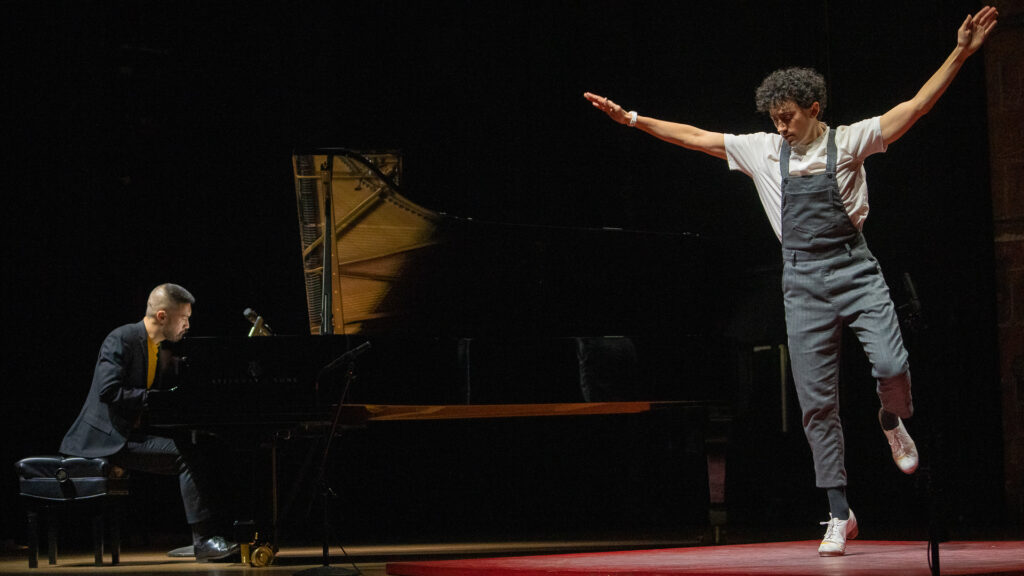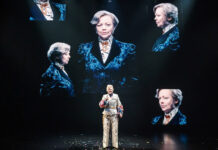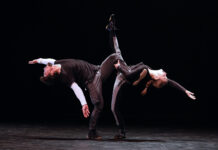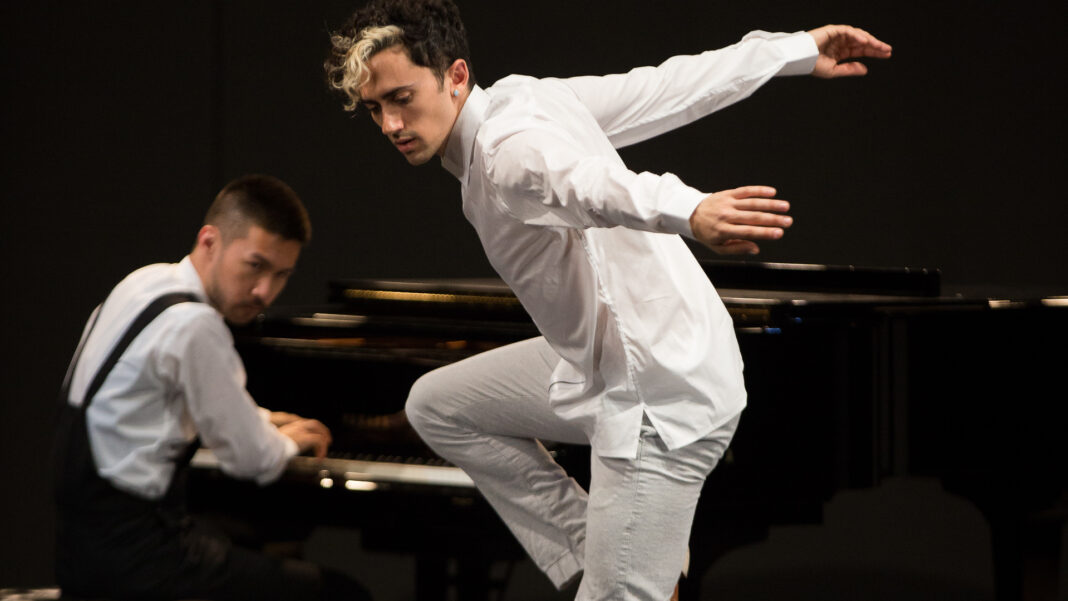According to the Oxford Dictionary, the definition of counterpoint, when applied to music, is “the art or technique of setting, writing, or playing a melody or melodies in conjunction with another, according to fixed rules.” Dancer/choreographer Caleb Teicher provides a different type of counterpoint to pianist/composer Conrad Tao when they perform their show entitled Counterpoint.
During a 70-minute performance Tao is at the piano playing music by Bach, Arnold Schoenberg, Art Tatum, George Gershwin and more while Teicher dances – most of it improvised. They will perform Counterpoint at The Nimoy Theatre, CAP UCLA’s newly opened theater in Westwood on Saturday, September 30th. They will also perform the show on October 6th at Artemus W. Ham Concert Hall at the University of Nevada, Las Vegas.
Both Teicher and Tao do a fair amount of improvisation as I learned when I spoke with Teicher earlier this week. What follows are excerpts from that conversation that have been edited for length and clarity. To see the full interview with Teicher, please go to our YouTube channel.
Q: Tap dancer Dianne Walker said in a story that she wrote for Dance Magazine in 2022 that when Tina Pratt introduced her to jazz pianist Barry Harris she really “got the improvisational connection between musician and dancer.” What was the process by which you got the improvisational connection between dancer and musician?
When I went to the New York City Tap Festival for the first time I met a teacher whose name was David Rider. And David was, for lack of a better way to describe it, very much in the modern day tap dance scene. Being in the modern day tap dance scene usually involves being very connected to the history, to the lineage, to the roots of this dance. And by that I mean I came into the dance a little bit late to meet a lot of the folks who had passed away.
The teachers who were at these festivals had a direct connection to the jazz tap tradition. That’s to say, the Black elders and the white elders of this dance form. When I started working with [David], I became aware of the importance of improvisation historically. Then as I started to tap dance more amongst the present day type community, I became aware of just how important it was to be an improviser and a good one.
What role do you allow or want improvisation to be part of what you do generally and specifically what you do with Conrad?
For what I do with Conrad, it’s mostly improvisation. Mostly because I want to feel really present with Conrad. We’ve played now the same set a number of times, and we both do different things to provoke each other to play, to show that we hear each other, to show that we’re in conversation. What is the point of gathering in person? To me, improvisation answers one aspect of that, which is to say, if it’s happening live, then you have to see it live.
What are the discoveries in that process that you’ve made about Conrad?
This is not a show I would do with any other pianist other than Conrad. It’s not I’m a tap dancer looking to do a show with a pianist. It’s I am myself, a dancer, looking to do a show with my friends and collaborators and someone who I’ve forged a long-lasting connection with. That’s Conrad.
Conrad and I met for the first time when we were teenagers and collaborated together for the first time when we were 19. Over the years we have become friends. I’ve seen so many of his shows and he’s seen so many of mine. This is not something that we’ve kind of put together just to make a show. This is something that came out of a shared respect and admiration for each other that led to something where it says, well, maybe we should share this connection that we have.
Gershwin’s Rhapsody in Blue is a huge component of Counterpoint. Can you break down in a basic manner how you came up with where each of you would take solos and particularly where the solo would become, in your case, the notes played with your feet?
I should say that while it’s improvised, every time we get to that particular section, Conrad does not play. That is something that is relatively set amongst this improvisation. My memory tells me that was Conrad’s idea and I just sort of humored him. I said, sure, I’ll try it. It was something that we always discussed doing together because it was such a fun piece and I had never danced it. Conrad had played Rhapsody quite a bit, but had never done it in a duo capacity
I think there are a lot of people who have very meaningful connections to Rhapsody. So it’s a relatively easy win. But also to both of us. I do feel like it goes through so many emotions, so many colors and textures and shapes. As I dance, I feel like in that 16-and-a-half minute experience I get to live such a full life. I get to do all these different things and explore my dancing in so many different ways. If it’s the thing that we are doing the most these days in terms of a piece, it continues to be a really fertile ground for our conversation.
You’ve been doing this show with Conrad for the past few years, do you want to expand it beyond what you’re doing now?
We just thought we were doing it once or twice. We had these three gigs back-to-back and we said if we don’t feel great about it after those three gigs, we’ll stop doing it. It turns out it was show two or something. We got to the dressing room and Conrad said that was really fun. The audience really took to it. So we said if people are willing to pay us to hang out and play music together that we enjoy, then who are we to argue?

The set has more or less stayed the same over the past couple of years. We don’t do this program every week. If we do six or eight engagements a year, that’s a lot. I’m happy to keep it as is for now. But we are performing it at the Gilmore in Kalamazoo, Michigan this year which has a piano festival. I believe they’ve commissioned a new piece for Counterpoint as part of that. So we will create one new piece for our duo this year, which is fun. We’ve discussed if maybe someday we really feel like a piece has seen the end of its time, then we’ll take it out. And if we’re excited about something new, then we’ll put it in. That is on the table.
There’s a composer named Jonny Greenwood whom I like very much. I like his work for film. I obviously like his work in the band Radiohead. When he was told that Radiohead is innovative and there are all these things that are great about Radiohead, he’s quoted as saying in response, “When people say you’re doing something radical in rock or dance music, I’m not sure how special that is. What we do is so old-fashioned. It’s like trying to do something innovative in tap dancing.” What would you say to someone who thinks that tap dancing is old-fashioned, whether it’s a rock star or somebody that you meet at a local store?
This is the nature of us, of our limited capacity to become familiar with the intricacies of things. Every community, every subculture, every genre of dance and music has a dense and rich and textured and complex history. It’s not uncommon for me to experience what I might be so bold as to call a sort of ignorance around the depth of tap dance.
Some of that is because tap dance has been historically marginalized because it came from Black culture and a lot of things that come from Black culture have been diminished in terms of understanding their complexity. But the truth is, I think everything is as beautiful or as rich as we make it. If someone thinks that something is simple, they’re just maybe not trying hard enough to see how beautiful something is.
To see the full interview with Caleb Teicher, please go here.
Main Photo: Conrad Tao and Caleb Teicher in Counterpoint (Photo by Em Watson/Courtesy CAP UCLA)











